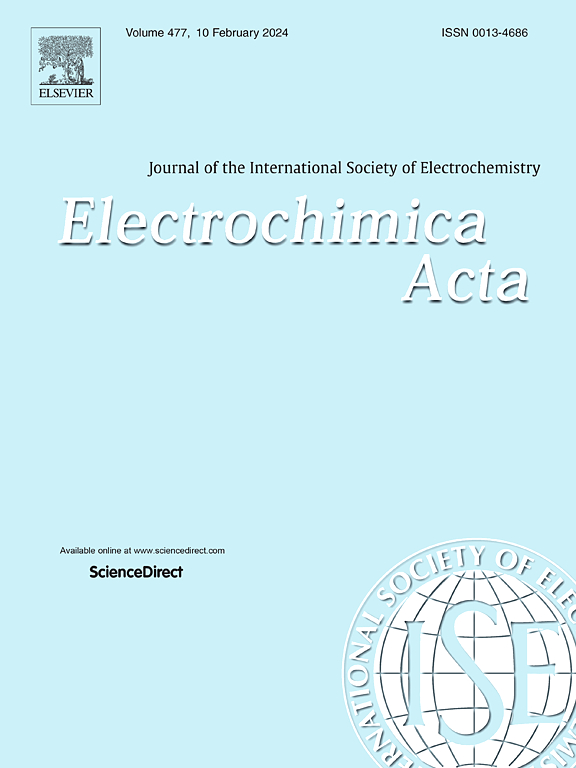研究用于太阳能电池和储能应用的可在空气中加工的 CsPbIBr₂包晶石电极的协同特性
IF 5.5
3区 材料科学
Q1 ELECTROCHEMISTRY
引用次数: 0
摘要
混合卤化物包晶材料具有优异的光电、离子和电子特性,这为将其作为一种高效的电极材料引入能量存储和转换应用提供了可能。在这项工作中,我们在环境条件下合成了 CsPbIBr2,并研究了其用于太阳能电池和储能设备的特性。我们采用 X 射线衍射 (XRD) 技术对合成的包晶晶体进行了结构表征。利用紫外-可见光谱、光致发光(PL)和漫反射(DR)光谱揭示了⁓ 2.1 eV 的光带隙。通过改变前驱体溶液的数量,初步调整了合成的 CsPbIBr2 包晶石用于太阳能电池器件的光伏性能,以获得最佳性能。在没有空穴传输层(HTL)和使用碳作为对电极的器件中,实现了 6.2% 的优化 PCE。阻抗光谱(IS)用于研究溶液量对界面电荷传输动力学的影响。此外,通过分析分别以不同扫描速率和电流密度记录的循环伏安(CV)伏安图和电静态充放电(GCD)曲线,阐明了该包晶石的电化学特性。在黑暗条件下记录的比容量为 570 C/g。我们的研究结果证明了这种包晶石的双重用途,并将为开发基于包晶石的新型潜在电极材料铺平道路,以用于能量转换和存储设备。本文章由计算机程序翻译,如有差异,请以英文原文为准。
Investigating the synergistic characteristics of air processable CsPbIBr₂ perovskite electrodes for solar cell and energy storage applications
Mixed halide perovskite materials exhibited excellent optoelectronic, ionic, and electronic properties, extending the possibility of introducing them as an efficient electrode material for energy storage and conversion applications. In this work, we performed the synthesis of CsPbIBr2 in ambient conditions and investigated its characteristics for solar cells and energy storage devices. The X-ray diffraction (XRD) technique is employed for the structural characterization of the as-synthesized perovskite crystals. The optical bandgap of ⁓ 2.1 eV is revealed utilizing UV–Vis, photoluminescence (PL), and diffuse reflectance (DR) spectroscopies. The photovoltaic performance of the as-synthesized CsPbIBr2 perovskite for solar cell devices is initially tuned by varying precursor solution quantity to obtain the optimum performance. The optimized PCE of 6.2 % is achieved for the device without a hole transport layer (HTL) and with carbon as the counter electrode. Impedance spectroscopy (IS) is employed to investigate the impact of solution quantity on interfacial charge transport kinetics. Further, the electrochemical properties of the perovskite are elucidated by analyzing cyclic voltammetry (CV) voltammograms, and galvanostatic charge-discharge (GCD) curves recorded at different scan rates and current densities, respectively. The specific capacity of 570 C/g is recorded under dark conditions. Our findings demonstrate the dual applications of the perovskites and will pave a pathway to develop new potential electrode materials based on perovskite for energy conversion and storage devices.
求助全文
通过发布文献求助,成功后即可免费获取论文全文。
去求助
来源期刊

Electrochimica Acta
工程技术-电化学
CiteScore
11.30
自引率
6.10%
发文量
1634
审稿时长
41 days
期刊介绍:
Electrochimica Acta is an international journal. It is intended for the publication of both original work and reviews in the field of electrochemistry. Electrochemistry should be interpreted to mean any of the research fields covered by the Divisions of the International Society of Electrochemistry listed below, as well as emerging scientific domains covered by ISE New Topics Committee.
 求助内容:
求助内容: 应助结果提醒方式:
应助结果提醒方式:


